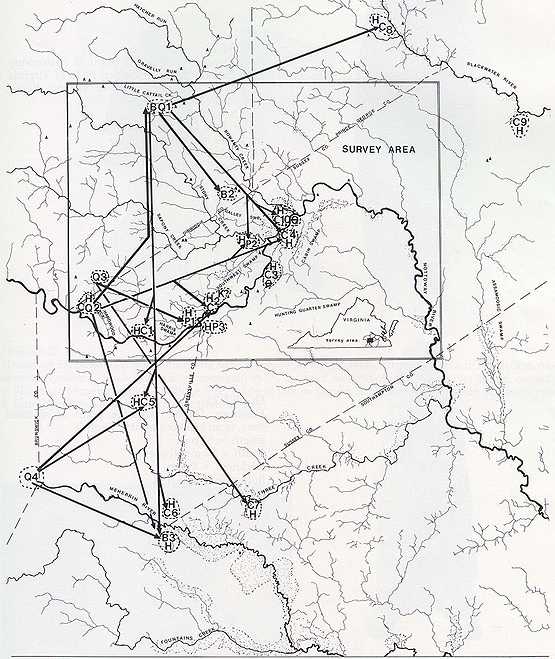"Q" or "Q" (with a horizontal slash) indicates a Quarry Site
The sites indicated are, from top to bottom: HC8, Tomko; HC9, Carpenter; BQ1, Williamson; B2, Conover; HC10(Q-slash), Hill; HC4, Slade; HP2, Sunflower; HC3, Fannin; HC2K, Baskerville; HP1, Harris Creek; HP3, Ridge; HC1, Hollowell; HCQ2, Mitchell; Q3, Bolster's Store; HC5, Otterdam Swamp; Q4, Brunswick; HC6, Meherrin River; HC7, Three Creek; HB3, Greensville County.
BQ1-Williamson Site: A distinctive lithic material, "Cattail Creek Chalcedony"
is varied in texture and color. Ranging from white and translucent to opaque black, the predominant forms are variegated in shades of brown, cream, grey and blue.
HC10(Q-slash)-Hill Site: The Paleo Indian hunters used local quartzite cobbles from the shoals of the Nottoway River. Williamson and Mitchell Quarry cherts are found in association with the Paleo Indian component of this site.
HC3-Fannin: The association of this site with quartzite cobbles found on the shoals of the Nottoway River; two of three Clovis points found were made from quartzite. Williamson and Mitchell cherts, as well as jasper and unknown cherts, were found in stratified deposits of Paleo Indian period age.
HCQ2-Mitchell Site: Located about 3/4 mile north of the Nottoway River, at least four outcrops containing Mitchell chert and chalcedony occur within crevises as a secondary or replacement material in large veins of quartz. Colors found in Mitchell chert range from white through dark brown; much of the material is light cream, grey, blue, violet, pink or yellow. Some jasper also occurs.
Q3-Bolsters' Store Site: Cherts, in the form of rounded and blocky masses and plates, and occurring on the red clay slopes north of Hardwood Creek, display a wide range of colors: red, brown, cream, yellow and blue-grey, and greens ranging from light to dark green to white. Some of the material found here can be thermally altered, however, no artifacts of Paleo Indian age have been found to be heat treated.
Q4-Brunswick Site: The chert here, fibrous in nature, is composed of microscopic chalcedony plates or blades in a chalcedony matrix. Colors are predominantly brown, red, cream and violet. A small amount of high-quality waxy material occurs, but most of this chert is grainy in texture.
Weathering Amber Chalcedony and Fossiliferous Grey Chert, two lithic materials found to have been used by the Paleo Indians in the Study Area, come from as yet undetermined sources. It is thought that the quarries probably are in the Chesterfield-Dinwiddie-Sussex-Greensville-Brunswick area along the Fall Line.
LINKS
Back
>>>>>MOBJACK BAY RELICS<<<<<
Lycos - Search the Web
CareerPath - Where Employers and Employees Click


